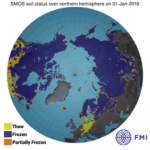What forests reveal when scanned with lasers
A new Nature Communications review article, led by Dr. Eduardo Maeda, shows how terrestrial laser scanning is transforming forest science. At the Earth Observation Unit of the Finnish Meteorological Institute (FMI), laser scanning and other geospatial technologies are applied from boreal forests in Finland to the tropics of Amazonia and Southeast Asia. Together with AI […]
Snow cover on Arctic sea ice is not staying in place – wind carries a significant part of it to more uneven areas
This uneven snow distribution affects how sea ice grows and how its thickness is measured by satellites. The new findings help improve climate models and satellite-based monitoring of the Arctic, both of which are crucial for understanding climate change. In a study published in the Journal of Glaciology, a team of researchers led by the […]
New Satellite-Based Methods for Monitoring Emissions from Cities and Power Stations
Satellites have proven to be a powerful tool for monitoring individual emission sources from space. Recent research highlights the significant potential of satellite data to reveal previously unreported or underestimated emissions, especially in regions where official emission inventories are delayed or incomplete. Tracking emissions from cities, power stations, and other major sources is critical for […]
Satellites reveal air pollution from the world’s largest copper mines
A new paper use satellite observations to highlight nitrogen oxide emissions coupled with copper production in open-pit mines https://doi.org/10.1088/1748-9326/adb767 Copper plays a crucial role in the global transition to a sustainable economy, serving as a key component in electric vehicles, solar panels, and wind turbines. However, copper mining also poses environmental and social challenges that […]
Climate Data Record of Stratospheric Aerosols (CREST)
Climate-related studies need information about the distribution of stratospheric aerosols, which influence the energy balance of the Earth’s atmosphere. A team of Finnish Meteorological Institute scientists, led by Viktoria Sofieva, has published a merged aerosol extinction profiles and stratospheric optical depth dataset available online: https://doi.org/10.57707/fmi-b2share.dfe14351fd8548bcaca3c2956b17f6655 The created aerosol climate record covers the period from […]
Evaluation of trends in boreal forest CO2 exchange by novel satellite data analysis
Hemispheric satellite data analysis shows that increase in gross primary production of boreal forests across 1981-2018 is balanced out by increase in ecosystem respiration. FMI-Space led investigation reveals that the variability in annual weather conditions affect more than earlier expected to the CO2 balance of evergreen boreal forests. In practice, increase in CO2 uptake (gross […]
New paper in Atmospheric Pollution Research
New results in this recently published paper propose improved nitrogen dioxide (NO2) to nitrogen oxide (NOx) scaling factors for several data-driven methods that are used for the estimation of NOx power plant emissions from satellite observations of NO2. The results from this work led by the Finnish Meteorological Institute will be utilized in the data […]
Improvements to monitoring the freeze/thaw state with radar satellites
The new study presents significant improvements to the existing methods, such as taking into consideration changes in the summer season. Soil F/T information is useful, for example, for users of heavy equipment, such as forestry machines. Soil freezing has a significant effect on the bearing capacity. Soil freeze/thaw (F/T) state in the boreal forest was […]
Significant funding for space weather research at Finnish Meteorological Institute
European Research Council awarded competetive ERC Consolidator Grant funding to Riku Järvinen’s project at Finnish Meteorological Institute. The grant is for five years and approximately two million euros. The project improves our understanding of space weather. The funded project studies space weather as observed by the European Space Agency’s and Japan Aerospace Exploration Agency’s BepiColombo […]
New model for snow reflectivity may enhance satellite measurements of carbon dioxide in the Arctic
New radiative transfer simulations at the Finnish Meteorological Institute will likely improve satellite remote sensing of carbon dioxide and therefore advance the study of the carbon cycle in the Arctic regions. The simulations support the planning of the European CO2M satellite mission. Doctoral researcher Antti Mikkonen at the Finnish Meteorological Institute devised a mathematical description […]



